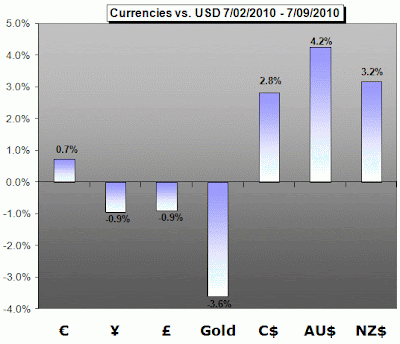
With the price of gold hovering around $1,200/oz, investors are wondering how much higher gold can go. In order to understand where the price will go from here, we must go back to the basics: supply and demand (note the illustration above). The supply of gold, which is mainly driven by mining, central bank sales, and scrap, has remained around 4,000 tones since 2000. Demand for gold is mainly driven by jewelry, industrial and dental uses, and investment purposes. In 2000, jewelry accounted for 80% of the demand for gold. However, in 2009 that number fell to nearly 40%. Additionally, investments in gold grew from less than 10% of demand in 2000 to over 40% of demand in 2009. Thus, with the demand for gold increasingly driven by investment purposes and the supply remaining relatively flat, we must ask ourselves, “How long do we expect investment demand to last?”
As
The Economist states, “Willem Buiter, a former professor at the London School of Economics who is now the chief economist of Citigroup, has called gold the subject of ‘the longest-lasting bubble in human history’. He says that he would not invest more than a sliver of his wealth ‘into something without intrinsic value, something whose positive value is based on nothing more than a set of self-confirming beliefs.’”
On the other hand, John Paulson, the well-known New York hedge-fund manager who bet correctly on the collapse of the subprime-mortgage market, holds $3 billion-worth of gold ETFs, the largest part of his $35 billion portfolio. Also, back in February of this year, newspapers revealed that George Soros doubled his investment in gold, holding a total of 6.2 million shares of SPDR Gold Trust. This news came even after Soros stated that “The ultimate asset bubble is gold.”
According to
The Economist, “As long as the world economy remains uncertain and investors fear inflation and sovereign default, gold will keep its allure. Eventually, however, the price will weaken: it is even possible that the recent slide to below $1,200 marks the turn. And investors may look back on the bull run of 2009-10—or 2009-11—with the sort of wonder that humanity has too often reserved for the yellow metal itself.”
In my opinion, gold has further upside potential. With uncertainty still remaining about the world economy, inflation, sovereign debt, and the value of currencies, investors are still looking for “safe havens” to store their money. Also, as one article that I came across states, “although gold achieved a nominal all-time high price of $1,226 per ounce in December 2009, it is still well below its 1980 price in real terms. Adjusted for inflation, the 1980 high of $873 per ounce is equivalent to over $2,200 today.” However, with this being said, we must keep a watchful eye on gold. It is possible that the recent rally in equities may be a sign that certainty is returning and that gold has met its peak.
Information cited from The Economist and other news sources.Daniel A.
Summer Analyst
Analyze Capital LLC
analyzecapital@gmail.com











.svg.png)





























